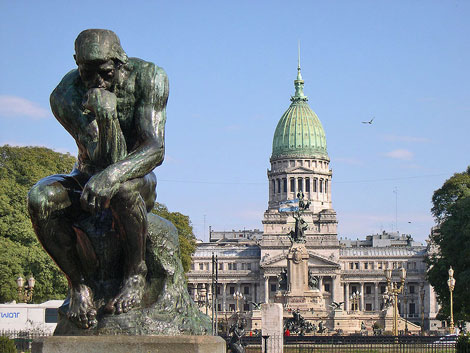
Do you have a favorite building in Buenos Aires? Mine is the one on the corner of Belgrano and Perú in San Telmo (see a picture of it here). The bottom two floors are nothing special – just roller doors that are always closed and then a set of shuttered windows – but on the third floor there appear a series of giant stone men who are carved so that they seem to be supporting the floors above on their shoulders. Then there are five or six floors of pretty balconies, and then it gets really wacky: three or four more levels built into a steeply sloping tiled roof topped by a pair of cupolas. It’s brilliant.
The architecture in Buenos Aires is easy to love. But how did it get that way?
Argentine Architectural Influences
The classical buildings in Buenos Aires are a mix of styles (particularly French and Italian), as you would expect in a city of immigrants. Many of them were built during the boom years of 1880 to 1920, which means that many of them are built in the neoclassical style that was popular around the world at that time (for reference ,the textbook example of this style of architecture is Washington, DC).
Around the microcentro and along the grand Avenida de Mayo between Plaza de Mayo and Plaza del Congreso there are many, many examples of neoclassical architecture. They include the National Congress, the Governor’s Palace, Teatro Colón and the Galerias Pacifico. The ancient-Greek-temple-inspired buildings such as the Cathedral Metropolitana on Plaza de Mayo and the University of Buenos Aires Law School are other exponents of the neoclassical style.
Often the most interesting details of the neoclassical buildings in Buenos Aires are seven or eight stories off the ground. Gargoyles, statues, cupolas, scrollwork and other flourishes adorn their upper extremities, giving you a lot of reasons to look up…which is pretty dangerous when you consider the state of the sidewalks!
Of course the architecture in Buenos Aires isn’t all classical. There are art nouveau and art deco buildings too, dilapidated colonial houses in San Telmo, colorful shacks around La Boca’s Caminito and gleaming towers in Puerto Madero. They’re all part of the mix (though in the case of Puerto Madero, a considerably less interesting part!), and altogether it’s a heady combination that could keep even a lifetime resident of Buenos Aires interested and intrigued.
Five of the best
Here are some of the best buildings in Buenos Aires, in the humble opinion of the author:
Teatro Colón (Cerrito 618)
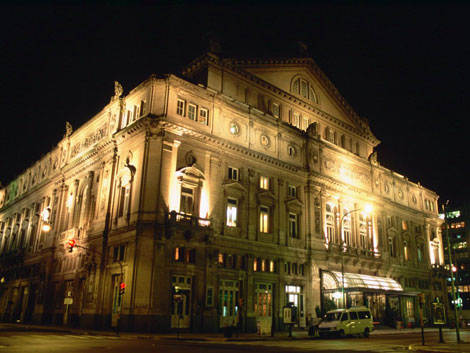
The grand opera house Teatro Colón is a Buenos Aires icon. It was built in 1908 and is considered one of five best opera houses in the world for acoustics. It’s built in the Italian style with some French decorations, and both inside and out it’s gorgeous. Most expats currently living in Buenos Aires won’t have seen inside Teatro Colón as it has been closed for refurbishments since 2006. It’s slated to reopen in May 2010 however.
Palacio Barolo (Avenida De Mayo 1370)
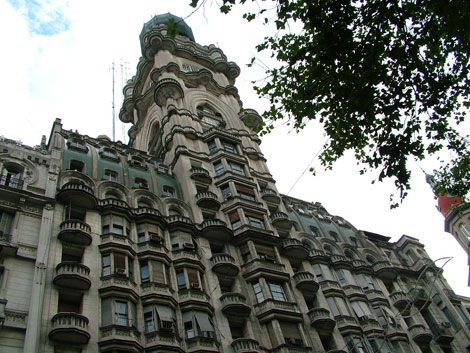
A great building with a whacky story behind it. Luis Barolo was a European immigrant who arrived in Argentina in 1890.At that time there was a widespread belief in Argentina that a succession of wars in Europe were going to utterly destroy it, and Luis was determined to save a part of it. And if all of Europe were to be engulfed in flames, what was the most important thing to save? Why the remains of the Italian poet Dante Alighieri; the author of the ‘The Divine Comedy’ who died in 1321, of course (obvious really). What a nutter. Anyway, the building is amazing, you can do guided tours and the views from the top offer an unmatched aerial view of the city.
Edificio Kavanagh (Florida 1065)
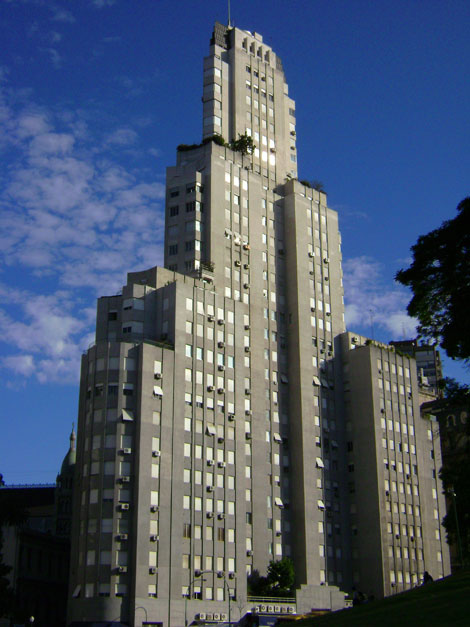
For a time the tallest building in South America, Edificio Kavanagh was the pet project of Corina Kavanagh and she lived in an apartment in the building for many years. It’s located in the barrio of Retiro, overlooks the Plaza San Martín, and is reminiscent of an art deco style American skyscraper.
Confitería Del Molino (Corner of Callao and Rivadavia)
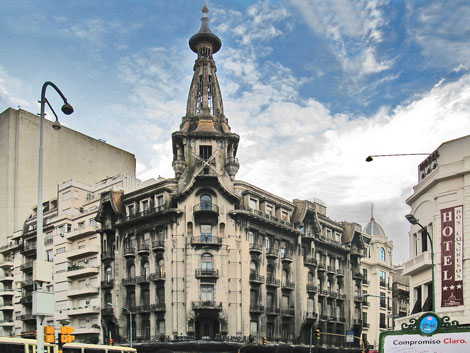
Confitería Del Molino stands out immediately for its grand turret complete with windmill sails (whacky, no?). It’s an art nouveau style coffeehouse that was built in 1917 by Francisco Gianotti, who also designed the art nouveau Galería Güemes. Unfortunately Confitería Del Molino has been closed now for many years, but you can admire the outside from the Plaza del Congreso.
Palacio de Aguas Corrientes
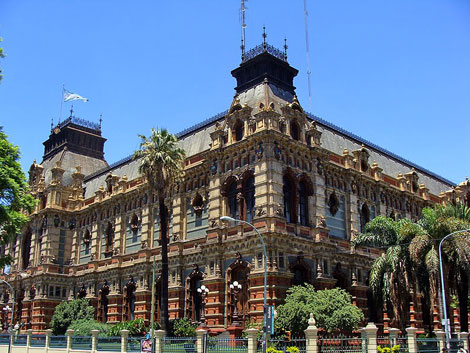
The fabulous Palacio de Aguas Corrientes (literally ‘the palace of running water’) was built in the late 1800s. It occupies an entire city block between the streets of Cordoba, Riobamba, Viamonte and Ayacucho. Its surroundings are shabby, but the building itself is a French renaissance palace covered in 300,000 glazed, multi-color terracotta tiles. It was built as a water pumping station, which is a little bizarre, because for something with such a functional purpose it’s utterly beautiful.

17 Comments on “Buenos Aires Architecture: A Quick Guide”
I loooooove Teatro Colón. Just gorgeous! And the inside is as beautiful as the outside. 🙂
I first came across Palacio de Aguas here http://tangogales.wordpress.com/2009/05/19/callao/
and with a number of tourists, just stood there trying to figure out what it was. It was truly astounding, it is just a shame they do not have a notice outside saying what it is.
Nice recap of the city’s architecture! I’m dying to tour Teatro Colón when it reopens.
i luv the Palacio de Aguas Corrientes! did u kno thats where GI JOE the movie was filmed??????????
You really have selected wonderfull buildings! I like the buildings in Alvear Avenue. There I found an interesting detail: there are the names of the architects in some of these buildings. Here I have my story in this avenue: http://euvou.blog.com/2011/01/gravado-pra-posteridade/ and here I found stamps with some of them. The text is in portuguese 🙁
greetings from Brazil
Hi! great post but I can´t see the link to ur fav building 🙁
Pingback: The Beauty of Buenos Aires Buildings
While I agree that not everything around Palacio de Aguas, is particularly beautiful…. but “Shabby”?!? Don’t go be talk’n bout my hood like dat.
If you do visit Palacio de Aguas, be sure to try Punta Cuore, the cafe at the corner of Cordoba y RioBamba it has a great view of the building and some of the best fried calamari I’ve had in BA.
I can´t believe it! The building on Perú and Belgrano is my favourite too!! Out of all the buildings in the city. I love it. I’m porteña, actually I don´t know why I’m writing in english.
But I’ve been reading this blog for a while now, and I think it’s really good. I’s interesting to see the city through the eyes of foreign people.
Thanks!
I love all those old buildings! They’re so elegant and stately, a far cry from the the boredom of modern architecture. I’s love to know more about the story behind some of those wonderful buildings.
Contgratulations for the great post! I`ve lived in Buenos Aires for 4 years and never got tired of looking up on my way to work. I would add 2 more to list: the Museo de Arte Decorativo, on Libertador ave, and Victoria Ocampo`s house, in Palermo Chico. She addapted the project herself, with Bustillo, after rejecting the first one, made by Le Corbusier.
Hi, congratulations, this is a great site with lot´s of info about Buenos Aires. If you wish to know more about Buenos Aires architecture visit detallesdebuenosaires.blogspot.com
Best regards, Andrés
LIVE IN ARGENTINA is the best of the world. BUENOS AIRES is the center and a massive city with good air. But the interior people and lands are more rich! secure! and we are waiting for friends in all places… come in and take a pair of good MATES… its blend is deep.. and the moment we live with it is deep and friendly too. we open aur heads, ears and heart. Dale Chamigo!!!
Other interesting part of argentinian and buenos aires is the urbanism… the base of the arquitecture. The rules of argentinian cities come from of “Leyes de India” a big big diference with the medieval european cities… in fact THERE IS BIG COUNTRY TO DISCOVER.. I would like to teach you more…but its better in direct. Love and live. @masluces
this is completely biased. I’ve never seen something like this! YOu guys carefully removed spain from the picture which is the main influence of Buenos aires Arch and no one can deny that IT IS A FACT. if you visit france italy and spain . and then you come to argentina . you’ll see that Buenos Aires looks way more like Barcelona and madrid , it actually looks nothing like and italian or french city . 3 or 4 french inspired buildings will never make B.A to look french it will ALWAYS look spanish before anything. YOu Italians just have to deal with it. I’ve noticed in Buenos aires that the Italo Argentines hate everything spanish and then they call it french.and to be honest Italian culture in argentina is secondary and weaker it comes across only in the food. YOU CAN’T DENY THAT.
why do you try to distant argentina from spain?
The things that people are attracted to B.A is mainly for the spanish side of it a.k.a Spanish and tango
NO one comes to argentina to eat italian so get over it.
Pingback: Entrada 3-Arquitectura en Buenos Aires | Gabriela Hernandez
Pingback: Architecture in Buenos Aires – My Semester Abroad: Buenos Aires, Argentina